Exhibition in Turin celebrates the most important family of Flemish artists
Pieter Brueghel the Elder and workshop, The Resurrection, ca. 1563, private collection, Belgium.
URIN.- The exhibition is dedicated to the Brueghel dynasty, inventors of a way of painting that quickly became the "trademark" of excellence in painting in a dynasty active for more than two centuries. Following its major success in Bologna, the exhibition is on view in the Rooms of the Arts of the Reggia di Venaria from 21 September 2016 to 19 February 2017.
The works on display tell the story – over a period of more than 150 years – of five generations working during the sixteenth and seventeenth centuries, and analyse the realist revolution championed by the brilliant founder of the family, Pieter Brueghel the Elder, followed by his sons Pieter Brueghel the Younger – who echoed his father's success with works such as the Outdoor Wedding Dance (1610 circa) and The Bird Trap (1601) – and Jan Brueghel the Elder, also called the "Velvet" Brueghel for the extraordinary perfection of his brushwork.
Also on display is the beautiful version of The Three Graces with a basket of flowers painted in 1635 by Jan Brueghel the Younger (Son of Jan Brueghel the Elder) together with Frans Wouters, and Large still life of fruit in a landscape (1670) by Abraham Brueghel (Great-grandson of Pieter Brueghel the Elder who specialized in still lifes). Marten van Cleve was one of the most attentive followers of the work of Pieter Brueghel the Elder. Between 1558 and 1560 van Cleve created his extraordinary series of six panels of the Peasant Wedding, and he also took on evangelical topics such as that of The Parable of the Good Shepherd (around 1578).
This collection is an exciting journey into the seventeenth century in search of the visionary genius of five generations of artists who – together – epitomized the style and tendencies of the golden age of Flemish painting like no one else before or after. But the path of the exhibit is also meant to invite the visitors into a playful, interactive experience; viewers have a chance to experience close-up the subjects of Nature so often represented in the artworks, peek into the secrets of the men, and – for example – "attending the peasant wedding”.
For the exhibition's stop in Turin, important new elements include several works from the mid-sixteenth century, Pieter Brueghel the Elder's most active period. In Antwerp, this founder of a dynasty – in addition to being appreciated as a radical innovator on biblical themes – is also known and praised for the quality of his depictions of everyday life.
With unsparing honesty he saw life as it really was; he painted the works of charity but also the weaknesses and daily miseries that affect everyone. Such, for example, is The Seven Acts of Mercy (circa 1616-18) by Pieter Brueghel the Younger.
Mighty Nature – looming over man, who is so often bent and subjugated in the face of its power – fully takes on the role of the real driver of human history. Nature is depicted with a visual richness, an attention to detail and a compositional beauty never before seen in the history of painting, as in the meticulous and detailed Landscape with the Parable of the Sower by Pieter Brueghel the Elder and Jacob Grimmer in 1557.
An important selection of artists are on display – from Frans de Momper to Frans Francken, from Hendrick van Balen to Joos de Momper, to many others whose work contributed to creating one of the richest, most detailed and most fascinating pages in art history – along with members of the Brueghel family, true masters of detail and specialists in painting animals, flowers and objects.
Moral judgment, sovereign nature, soldiers and hunters, travellers and merchants, allegories and parables, splendour and vanity, silent life and dance of the lowliest: these are the titles of the sections of the exhibition; around these themes a fascinating story will unfold of the lifelike reality and the meticulous care with which the world is described, like the reflection in a mirror.
Pieter Brueghel the Younger, The Seven Acts of Mercy, 1616, Private collection, Belgium.
First section – Moral judgment; salvation and condemnation
The course of the exhibition begins with Flanders in the mid-sixteenth century in order to underscore the dialogue between the moral and visionary fantasy of The Seven Deadly Sins by Hieronymus Bosch (1500 - 1515) and the painting of Pieter Brueghel the Elder, head of the most important family of Flemish artists of the sixteenth and seventeenth centuries, with his painting on display here, The Resurrection from circa 1563.
Brueghel's eye captures a simple humanity, free yet at the same time a slave to needs, constantly shifting between the spiritual inclination to virtue and the carnal seductions of vice.
Hieronymus Bosch, The Seven Deadly Sins, 1500-1515, Geneva Fine Arts Foundation, Geneva.
Second section – Sovereign nature
In Flemish painting, the Copernican Revolution does not consider man to be at the centre of the universe but makes him part of a more powerful and complex world. Even for purposes of the Protestant Reformation and the Calvinist theories, the focus of art shifted towards the primacy of nature, which Jan Brueghel the Elder in particular, called the Velvet Brueghel, painted with meticulous care in Rest on the Flight into Egypt (circa 1602-1605) and in River Landscape with Bathers (circa 1595-1600).
These works launched a journey into a new perception of reality, creating awe and a sense of humanity's limits before the power of the elements in a threatening though attractive world. The large canvas A Wooded Landscape with the Virgin and Child, Infant Saint John the Baptist and an Angel (circa 1645-1650) by Jan Brueghel the Younger is a classic example.
In this section, for the first time, the works of van Cleve immediately proved very popular, so much so that they were well known by the next generation of artists, including, for example, Pieter Brueghel the Younger. Some scholars believe that the work The Parable of the Good Shepherd (circa 1578), on display here, stems from a now lost original by Pieter Brueghel the Elder.
The charming panel Flemish Village with Peasants at Work in the Fields (circa 1565) is the result of collaboration between Marten van Cleve and Jacob Grimmer.
Jan Brueghel II, Rest on the Flight into Egypt, circa 1602-1605, Private Collection, Luxembourg.
Jan Bruegel, River Landscape with Bathers, ca. 1595-1600
Third section - Soldiers and hunters in winter light
The Bird Trap (1601) is one of the most famous scenes in Flemish painting, and Pieter Brueghel the Younger gives us a masterful version based on the original by his father. In a sublime wintertime atmosphere, hunters wait for animals to fall into a trap while men, women and children skate on the frozen river, all heedless of danger. The idea of the transience of life is rendered with mastery, and this is the section of the exhibition that shows the most raw and realistic aspects of everyday life. A similar theme is treated by Marten van Cleve with his A Winter Landscape with the Massacre of the Innocents (circa 1570).
Pieter Brueghel the Younger, Trap for birds, 1601. Private Collection, Luxembourg.
Marten van Cleve, Winter Landscape with the Massacre of the Innocents, ca. 1570, private collection, Belgium.
Fourth section - Stories of travellers and merchants
In the sixteenth century, the city of Antwerp was a centre for commerce, for expeditions and great journeys. The city saw the birth and establishment of a new bourgeois class that dared the unpredictable trade routes of the seas in search of wealth. Painting celebrated the exploits and adventures of travellers and merchants. Their stories inspired paintings that grew ever more common and well-appreciated, destined to grace the homes of a cultured clientele attentive to the dynamics of a new market. Engravings such as Jan Brueghel the Younger's Travellers at a Meeting Point (circa 1630) were particularly successful.

Jan Brueghel the Younger, Peasants Returning from the Market, circa 1630, oil on copper inserted in panel, 12,7 × 15 cm, New York, private collection.
Fifth section - Allegories, tales of wonder
Allegories are large visual metaphors, a very effective way to make concepts such as love, war, peace, the elements of nature and the human senses visible and immediately comprehensible. Allegory of Love (circa 1648-1650) and Allegory of Hearing (circa 1645-1650) are paintings that demonstrate Pieter Brueghel the Younger's unique skill in this genre. The narrative route of the exhibition concludes with a series of works with a strong emotional impact that complement the artistic and creative path of the extraordinary Brueghel dynasty.
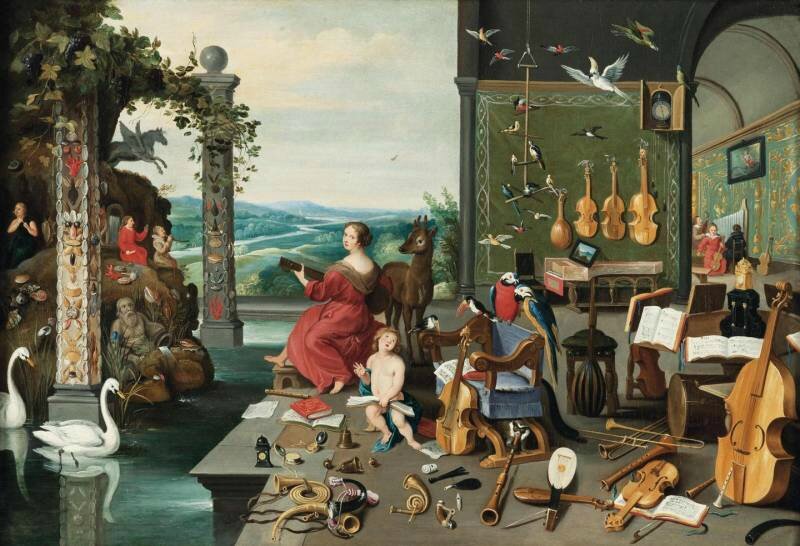
Jan Brueghel the Younger, The Allegory of Hearing, circa 1645 - 1650, oil on canvas, 57 × 82,5 cm, Genève, Collection Diana Kreuger.
New elements at Reggia di Venaria include the noteworthy oil on copper The Three Graces with a basket of flowers (circa 1635) by Jan Brueghel the Younger and Frans Wouters, a pupil of Rubens. It's a painting that's clearly related to Rubens' famous painting now kept in Vienna, presenting the same subject and setting, inspired by the sculptural group belonging to the Piccolomini.
Jan Brueghel the Younger and Frans Wouters, The Three Graces with a basket of flowers, circa 1635, Private Collection, Luxembourg.
In the painting on display it is easy to recognize the hand of Frans Wouters, who adopted the master's famous plasticism to realize the female figures, while Jan Brueghel with all his skill rendered the landscape and the large basket of flowers. This moment was the apex of the splendour of the "Brueghel style" – with the details that shine with minute, luxurious touches, the dazzling colours, the imaginative vein – like in Sleeping Nymphs Observed by Satyrs (circa 1640) by Jan Brueghel the Younger and Jan van Boeckhorst – for which the Flemish school is known throughout Europe.
One more important painter of particular interest who will be shown at the Venaria Reale is Paolo Fiammingo, a Northerner who became a resident of Italy. Fiammingo combines mastery aided by a lengthy journey around the Italian peninsula, the great lesson of Italian Renaissance painting, the Venetian sense of colour and the taste for details and landscapes typical of Flemish painting. Diana and Her Nymphs Surprised by Actaeon (circa 1580) is a large, thick copper plate cut following the sixteenth-century technique, which shows Actaeon first transformed into a stag and then devoured by his own dogs as punishment for spying on the goddess Diana and her nymphs while they relaxed by a river after hunting.
The scene is set in a dense forest, where each leaf is explored with pinpoint perfection, while at the centre of the scene a small floral still life shows Paolo Fiammingo's skill in depicting the plants that the science of the time had begun to catalogue.
The centre of the painting, however, is entirely occupied by the sensual and slender nude bodies, only partially wrapped in cloths rich with vibrant, electric colours and broad scrolls in proto-Baroque style.
Franck Pauwels called Paolo Fiammingo, Diana, the Nymphs and Actaeon, ca. 1580, Private Collection, Luxembourg.
Sixth section - Splendour and vanity of the silent life
If it is true that flowers symbolize harmony and wealth, it is also true that they always conceal within the idea of vanitas, of that that does not last because all beautiful things are destined to perish. Even in large still lifes, we can actually perceive the silent life flowing, a subtle presence. The moral message of the transience of time is underscored by details such as an overripe fruit or a dead leaf. In Still life with flowers in a basket and a clay pot (1640-1645) Jan Brueghel the Younger has chosen a cinerary urn for a vase, as if to recall the common inexorable destination. Of particular interest are the small compositions Still Life with Flowers (1660-1665) and Vase with Tulips and Dahlias (circa 1645-1650) by Ambrosius Brueghel.
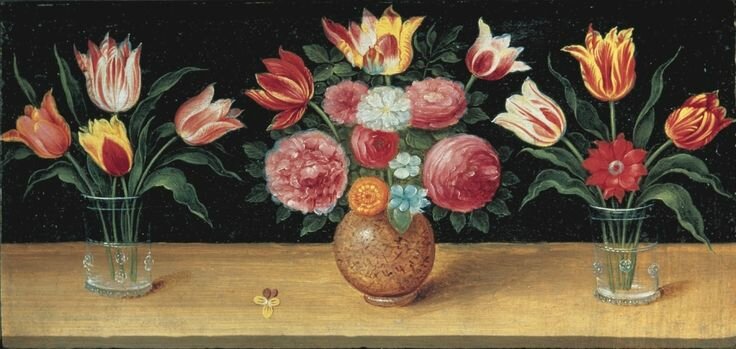
Ambrosius Brueghel, Still Life with Flowers, 1660 - 1665. Oil on canvas, 12.5 x 26.5 cm (each) Vermont, private collection.
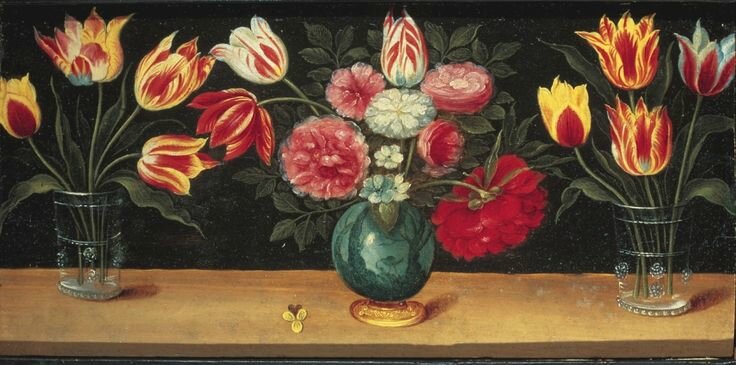
Ambrosius Brueghel. Still Life with Flowers, 1660 - 1665. Oil on canvas, 12.5 x 26.5 cm (each) Vermont, private collection.

Ambrosius Brueghel, Vase with tulips and dahlias, ca. 1645-1650, private collection, Amsterdam.
Seventh section - The dance of the lowliest
The Brueghels are narrators of stories and of reality. In their works, there is the story of real life – there are peasants bent over from the fatigue of living, drunks, beggars, characters seen only from behind and anonymous figures carrying on with the course of their existence, ignorant of and indifferent to the outside observer looking at the painting.
The Outdoor Wedding Dance of 1610 and The Whitsun Bride by Pieter Brueghel the Younger (1620-1623) are artworks that exemplify this. The course of the exhibit comes to a close with Marten van Cleve's Peasant Couple Attacked by Robbers (circa 1576), now in Turin for the first tim.
Pieter Brueghel the Younger, Bridal Dance outdoors, ca. 1610, private collection, USA.
The works on display tell the story – over a period of more than 150 years – of five generations working during the sixteenth and seventeenth centuries, and analyse the realist revolution championed by the brilliant founder of the family, Pieter Brueghel the Elder, followed by his sons Pieter Brueghel the Younger – who echoed his father's success with works such as the Outdoor Wedding Dance (1610 circa) and The Bird Trap (1601) – and Jan Brueghel the Elder, also called the "Velvet" Brueghel for the extraordinary perfection of his brushwork.

/https%3A%2F%2Fprofilepics.canalblog.com%2Fprofilepics%2F1%2F0%2F100183.jpg)
/https%3A%2F%2Fstorage.canalblog.com%2F03%2F02%2F119589%2F96711876_o.jpg)
/https%3A%2F%2Fstorage.canalblog.com%2F11%2F31%2F119589%2F94773502_o.jpg)
/https%3A%2F%2Fstorage.canalblog.com%2F20%2F83%2F119589%2F94772815_o.jpg)
/https%3A%2F%2Fstorage.canalblog.com%2F26%2F72%2F119589%2F75604929_o.jpg)
/https%3A%2F%2Fstorage.canalblog.com%2F59%2F60%2F119589%2F26458628_o.jpg)
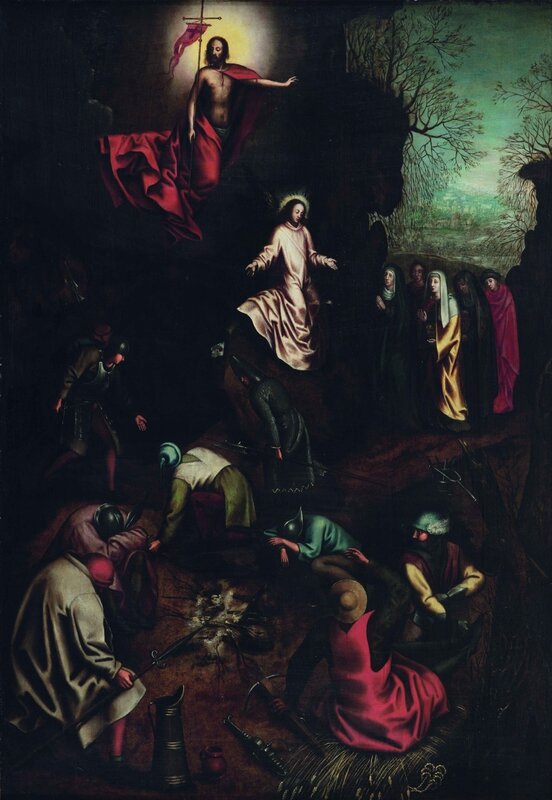




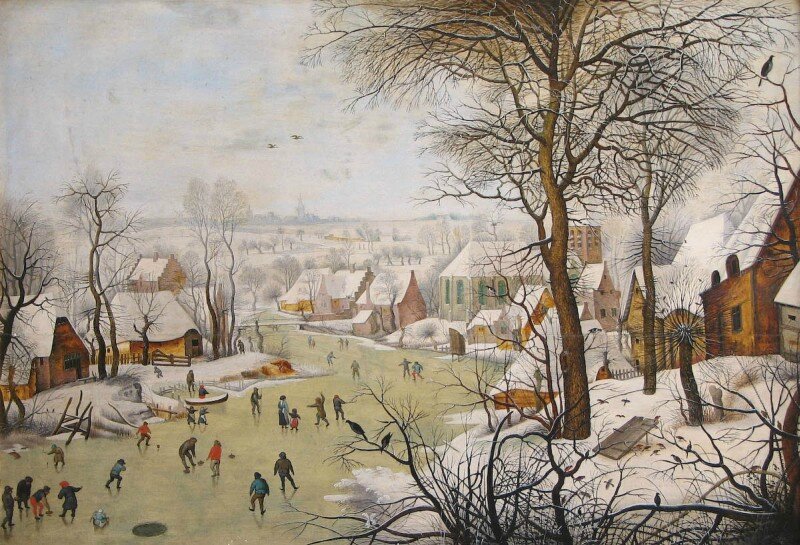


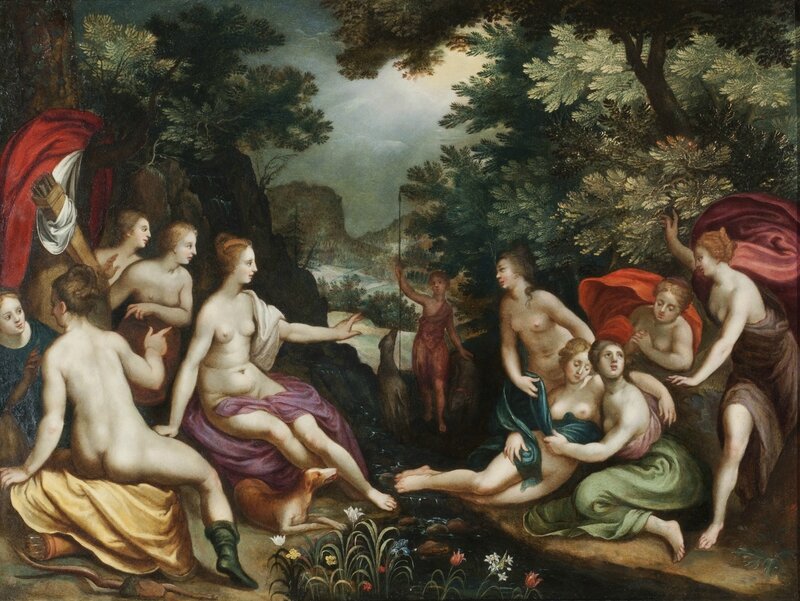





/http%3A%2F%2Fstorage.canalblog.com%2F94%2F09%2F119589%2F128556743_o.jpg)
/http%3A%2F%2Fstorage.canalblog.com%2F00%2F82%2F119589%2F122298365_o.jpg)
/http%3A%2F%2Fstorage.canalblog.com%2F68%2F17%2F119589%2F122146900_o.jpg)
/http%3A%2F%2Fstorage.canalblog.com%2F08%2F96%2F119589%2F95234076_o.jpg)